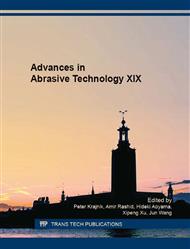p.297
p.302
p.308
p.313
p.323
p.328
p.333
p.339
p.345
Nanotwinned Surface on a Ternary Titanium Alloy with Increased Hardness Induced under Nanoindentations
Abstract:
A nanotwinned surface is formed on a titanium alloy under nanoindentations. Prior to nanoindentation, blocks of a ternary titanium alloy are machined by chemical mechanical polishing. The surface roughness Ra and peak-to-valley values are 1.135 nm and 8.82 nm, respectively. The hardness in the indented surface is greatly increased, indicated from the load-displacement curves compared to the polished surfaces. Nanotwins are confirmed using transmission electron microscopy. The nanotwinned surface is uniformly generated by nanoindentations at room temperature, which is different from previous findings, in which high temperature, high pressure, or chemical reagents are usually used. The nanotwinned surface is produced by pure mechanical stress, neither material removal nor addition.
Info:
Periodical:
Pages:
323-327
Citation:
Online since:
October 2016
Authors:
Price:
Сopyright:
© 2016 Trans Tech Publications Ltd. All Rights Reserved
Share:
Citation:


